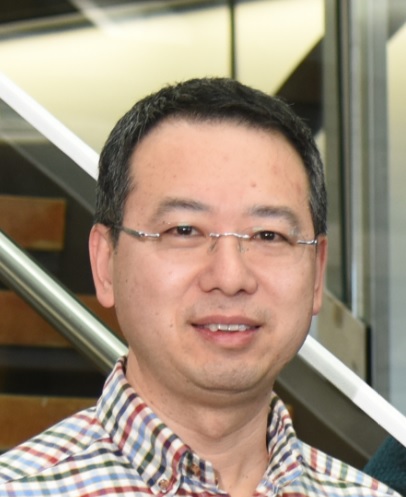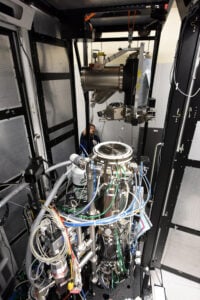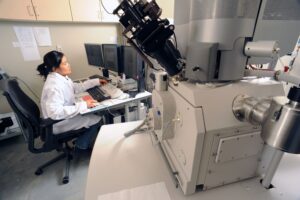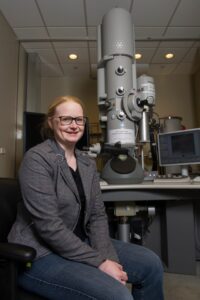Microscopy and Characterization Suite
The Microscopy and Characterization Suite (MaCS) provides the organization and infrastructure to make various materials characterization tools available for research, academia, and regional companies. The Microscopy and Characterization Suite (MaCS) is a state-of-the-art materials characterization laboratory that provides cross-cutting capabilities that support the Center for Advanced Energy Studies’ (CAES) mission in multiple initiative areas. MaCS is largely made possible through its partnership with the Nuclear Science User Facilities (NSUF).
MaCS is complementary to the Boise State Center for Materials Characterization (BSCMC) that was established by the Idaho State Board of Education in August 2006 to provide a state-of-the-art characterization facility in order to attract more students into science and engineering careers, to improve science and engineering education at the undergraduate and graduate levels, and to foster leading research and interaction with local industry.
Collectively, MaCS and BSCMC provide the organization and infrastructure to make various materials characterization tools available for research, academia, and regional companies.
Staff & Contacts
Dr. Yaqiao Wu
MaCS Director & Instrument Lead, AML Lead
Email: [email protected]
Office: (208) 533-8112
Instruments: Local Electrode Atom Probe (LEAP), Transmission Electron Microscope (TEM)
Affiliated with: Boise State University
Jana Howard
Research Associate
Email: [email protected]
Office: (208) 533-9530
Affiliated with: Boise State University
Dr. Yu Lu
Co-Instrument Lead of FIB, LEAP and Nanoindenter/AFM
Email: [email protected]
Office: (208) 533-8160
Instruments: FIB, Local Electrode Atom Probe (LEAP), Nanoindenter, and XRD
Affiliated with: Boise State University
Ching-Heng Shiau
Post Doctoral Researcher
Email: [email protected]
Office: (208) 533-8210
Instruments: Transmission Electron Microscope (TEM), SEM
Affiliated with: Boise State University
Sidharth (Sid) Sukumaran Nair
Research Associate
Email: [email protected]
Office: (208) 533-9326
Affiliated with: Boise State University
Quick Facts
- MaCS has the capabilities to characterize a wide range of materials, including metals, semiconductors, ceramics, coal and minerals in bulk or powder forms, as well as some organic cellular materials
- It can provide 2-D/3-D morphology, chemical information, and mechanical testing data from micron to atomic scale
- Research includes analysis of nuclear fuels and materials, geological samples, feedstocks for biofuels, stainless steel alloys, ceramics and more
Working in MaCS
Nonradioactive Samples
- Equipment: All imaging instruments and sample prep equipment may be used in MaCS for nonradioactive materials.
- All imaging and sample prep activities shall be performed in accordance with CAES Operating Procedures.
Radioactive Samples
Materials: Radioactive material requests are evaluated as they are made, with consideration given to 1) whether the cumulative CAES inventory limit will be exceeded and 2) changing the CAES operating envelope for radiological materials.
The current rad operating envelope includes depleted uranium, solid activated ceramics, and fixed radiation sources. Depleted uranium may be in solid forms. Fixed radiation sources include activated metals: solid, non-dispersible, smearably clean (i.e., considered to be free of removable radioactive contamination) samples of activated metal and solid ceramic materials that are prepared to minimize sample mass and have a gamma dose rate of less than 70 millirem per hour at 30 centimeters are generally acceptable for analysis and testing in CAES.
- Sample Receipt: Every effort should be made to send samples as clean as possible (i.e. minimize the removable contamination). The shipper must follow all applicable DOT shipping requirements, and inner containers including sample holders will be less than 7 dpm/100 cm2 alpha and 70 dpm/100 cm2 beta/gamma. If the measured activity levels of materials are not consistent with the types and levels specified in the shipping manifest and approved RPR13, if the sample containers are at all compromised, or the number of, or labeling of samples no not match the information provided by the researcher/shipper, the materials will be immediately returned to the shipper.
- Sample Preparation: Minor sample touch-up is the only sample prep activity allowed for radioactive samples. Touch-up shall be performed in accordance with CAES Operating Procedures, with each activity planned and approved on a project-by-project basis. Some nuclides may prove to be unacceptable for sample preparation until Phase 2. This reinforces the need to fully vet sample prep activities in the service request step of the process.
- Equipment: All imaging equipment may be used for radiological sample analysis.
Starting from October 1st, 2024, MaCS scheduling will be managed by INL and switched to the INL P6 system. The MaCS team collaborates with INL MFC P6 schedulers on the tool schedules. To request tool time at MaCS, users may either talk to MaCS Instrument Leads or send emails to [email protected]. A scope of work and an acknowledgement of non-export-controlled project will be required before any tests can be performed at MaCS. Trained/signed-off users can request off-hour sessions.
Complete the following:
- CAES Facility Orientation
- Core Lab Training
- MaCS Specific Lab Training
- The Lab Lead walk through will be conducted before you begin working in MaCS by the Lab Lead or Alternate Designee.
The MaCS lab is a radiological laboratory, therefore radiological and non radiological MaCS workers must complete Idaho State University (ISU) radiological training.
Lab News
CAES hosts VIPs from Ohio State University
CAES hosted a great visit by Ohio State University’s Center for Design and Manufacturing Excellence this week. Ed Herderick, the Center’s Additive Manufacturing director, and Executive Director Nate Ames, received...
Read MoreMaCS Seed Grant Program Awards up to $5K each
The Center for Advanced Energy Studies (CAES) is pleased to announce a MaCS Seed Grant Program. With support from Boise State CAES, Idaho State CAES, and the Boise State Micron...
Read MoreCAES holds virtual groundbreaking ceremony for new transmission electron microscope
The Center for Advanced Energy Studies (CAES) held a virtual groundbreaking ceremony on July 16 for a $5M project to install a new Transmission Electron Microscope (TEM). This state-of-the-art piece...
Read MoreNaval Academy Researcher Uses Microscopy and Characterization Suite
By Paul Menser, for CAES Communications It was a homecoming of sorts when Dr. Elizabeth Getto came to the Center for Advanced Energy Studies (CAES) to make use of its...
Read More
